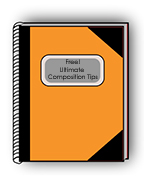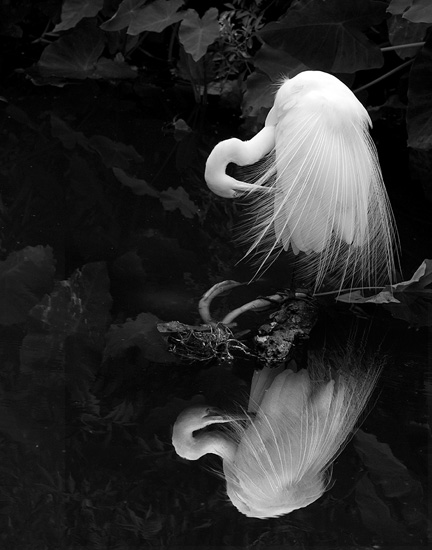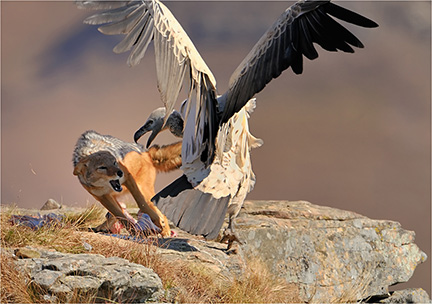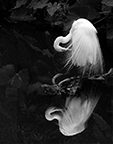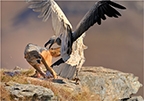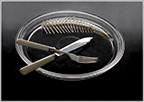All photos and text © Julie Waterhouse, all rights reserved worldwide. No form of reproduction or usage (including copying in whole or in part, or altering of digital image and text files) is permitted without the express written permission of Julie Waterhouse.
Depth of field is one of the most significant considerations in close-up photography, which is why we include a discussion of it early in the course. Why is depth of field so significant? Depth of field presents a special challenge in close-up photography because you have so little of it! The closer you are to the subject, the less of it you will be able to get in focus from front to back — sometimes only a millimetre or two.
What is Aperture?

image source: wikipedia.org
Your aperture setting controls your depth of field, so we begin with an explanation of aperture. Simply put, your aperture is the opening in your lens that lets light through. You are able to control the size of that opening from small to large. The aperture you choose affects both your exposure and your depth of field.
The size of opening is measured in units called f-stops. Each stop up or down will double or halve the amount of light passing through, i.e., each aperture stop lets through half the light of the previous one. The standard f-stops are f/2.8, f/4, f/5.6, f/8, f/11, f/16, f/22 (see the image below). The numbers themselves don’t double or halve, so you just need to remember them. But the area of the opening that each number represents is double or half the area of the next f-stop.
Most of today’s SLR cameras allow you to change your f-stops in increments of one half or one third of a stop, giving you some numbers in between the standard f-stops for finer control.
Image 1 on the right shows a large opening in the lens (perhaps something like f/2.8). Image 2 shows a smaller opening (perhaps something like f/22).

Standard f-stops: image source: wikipedia.org
What is Depth of Field (DOF)?
Depth of field refers to how much of the image is in focus from front to back. When you focus your lens on a particular point, you will actually have a range of space in the image that is in focus. This range is your depth of field. One third of that in-focus range (or DOF) will be in front of your focal point, and two thirds will be behind it.

Depth of field.
© Julie Waterhouse Photography.
The aperture setting you choose will determine how deep this in-focus range (or DOF) is. A small aperture of f/22 will have a large depth of field (a lot in focus), and a large aperture of f/2.8 will have a shallow depth of field (very little in focus).

© Julie Waterhouse Photography
At f/2.8, most of the image is soft. Only the nearest edges of the curly petals are in focus. At f/8.0, some of the flower’s centre, but not all of it, is in focus. A little more of the curly petals are in focus, but the long petals at the bottom are still soft. At f/22, everything is sharp.
Selective Focus
Selective focus is a technique where you use a wide aperture to get a very shallow depth of field. You then select just one part of the image to be in focus, and let everything else fall out of focus, or be "soft." This is an effective way to draw attention to one part of the image. Choose your point of focus carefully, since your eye is naturally drawn to whatever is sharp. The soft areas of the image just provide a background wash of colour(s).
Technique 1: Keep in mind that it’s difficult to make a successful image where nothing is in focus. Typically, you need to have something in focus to provide a place for the eye to rest when viewing the image.
Technique 2: You will need to use manual focus on your lens, and not auto focus, to use this selective focus technique. You want to be able to move the plane of focus through the object from front to back, looking for the right spot to highlight.
Selective focus example 1
In each photograph below, I kept the camera position the same, and fixed my aperture at f/2.8. I just turned the focusing ring on my lens to pick focal points at different depths into the image. In the first image, I focused on a part of the flower close to the lens. In each subsequent image, I moved the focal point further away.
Notice that each image looks completely different, and the only variable I am changing is where I am choosing to selectively focus. Selective focus has a significant impact on the final image.

© Julie Waterhouse Photography

© Julie Waterhouse Photography

© Julie Waterhouse Photography

© Julie Waterhouse Photography
In each image above, notice how you eye immediately travels to the bit that’s sharp.
In this case, I don’t think any of the images works at such a shallow depth of field. In every image, my eye wants to see more of the flower in focus.
Part of the problem is that the foreground is out of focus in all the images, even though things further away are in focus. This always bothers our eyes. We can accept things in the distance being less in focus than things close up. We are used to effects like this in real life. For example, mountains in the distance may appear "soft" due to atmospheric haze. However, in real life, we never see the opposite: close objects being out of focus while things behind them are in focus. It is usually disturbing.
In this set of images, the only one with any foreground material in focus is the first, and it doesn’t have enough other things in focus to "work" as a strong image.
Selective focus example 2
In this example, selective focus is very powerful. We have one edge in the image that’s sharp at a carefully chosen, "interesting" place, i.e., where the petal edge dips. Notice that this is also the closest point on the flower to the camera, so it’s not disturbing to our eye.

f/2.8
© Julie Waterhouse Photography
Sometimes, selective focus is crucial to the success of the image. In the version below, I have used a lot of depth of field without changing the composition from the one above. Now, the image is a mess! All of a sudden, there’s a distracting dark spot in the bottom left, and there are other petal edges starting to come into focus to compete for our attention.
The main petal edge that’s visible in the image above is where the story is. Everything else just distracts. A shallow depth of field is essential to make this image successful.

f/22
© Julie Waterhouse Photography
Minimise Distracting Backgrounds
In Lesson 4, we’ll talk in more detail about eliminating distractions from our images. One of the tools we use to do this is a shallow depth of field. As you saw in the pair of images from the selective focus example above, much of the image goes soft and out of focus when there is not much depth of field. That blurring can cover a multitude of sins! Because we are working so close to our subject, and our depth of field is very small to begin with, the effect of a shallow depth of field is very powerful. Lines and shapes are completely blurred and all detail is lost. This can be used to your advantage if your background is busy. As long as the background elements are far enough away from your main subject, they will go soft while your subject remains sharp.

f/22
© Julie Waterhouse Photography
In this example, the subject is the flower on the right. However, on the left side of the image, we have other flowers (including dirty marks on some of the petals), green in the top left from a flower stem, and a black gap at the bottom where the dark background shows through. All of this takes attention away from our main subject.

f/2.8
© Julie Waterhouse Photography
Switching from a deep depth of field at f/22, to a very shallow depth of field at f/2.8, completely eliminates all that background clutter, reducing it to a soft wash of white tones. Now our eyes stay where they are supposed to: on the flower at the right.

© Julie Waterhouse Photography
A shallow depth of field is used to isolate this Sweet William flower against the background. Any detail in the green is lost in the blur.
In this case, I’m a little further from my subject than in the previous examples. That means I have more depth of field available to me. In order to make the background go completely soft, the flower has to be separated from the background by some distance.
How to Choose the "Correct" Depth of Field
First of all, what is the "correct" depth of field? What does that mean? If you’re not using a shallow depth of field to cover up a messy situation, then there is no "correct" depth of field in an absolute sense. Your choice of depth of field becomes a creative one. The "correct" depth of field is the one that best supports the story you want to tell.
Typically, you use a large, or deep, depth of field if detail is important, and you want everything in the image to be sharp. A sharp image is representative of reality. In other words, that’s how we actually see small objects: all in focus.
You use a shallow depth of field to obtain a more artistic, painterly feel to the image. A soft image is not representative of reality. It is something that can only be created through the magic of our cameras.

© Julie Waterhouse Photography
In this close-up of the centre of a lily, I used a large depth of field (f/22) so that everything in the image would be sharp. In this case, I wanted to emphasise the details of the flower – the spots on the petals, and the fuzzy texture of the pollen on the tips of the stamens.
Many nature photographers are concerned with showing off the details of their subjects, and presenting them in a literal and documentary fashion. A large depth of field is appropriate for this purpose.

© Julie Waterhouse Photography
This image of a gladiolus is much more interpretive than the above image of the lily. Although the compositional structure, and even the colouring of the two images are very similar, the "feel" of the images is completely different. While the first image might make you admire the precision and delicacy of the flower’s parts, this emphasises the gentle qualities of the flower. It has a dream-like quality that evokes more of an emotional response than an analytical one.
Which approach is "correct?" I hope you said "neither!" The decision of how to photograph the flower is entirely subjective. This is a decision that you, as the photographer, must make. That’s why it’s essential to get your camera off program mode, and into manual mode (or aperture priority), so that you exercise creative control when making your images.
What do you want to emphasise? To me, the first image below, with the shallow depth of field, shows off the star shape of the flower, which is echoed by the star arrangement of its stamens.
In the second image, with a lot of depth of field, the detail and texture of the flower are emphasised. I find that the left side of the image, containing all the unopened buds, becomes distracting with a lot of depth of field. It suddenly carries more visual weight, and pulls my eye away from the main flower.
What do you think?

f/2.8
© Julie Waterhouse Photography

f/22
© Julie Waterhouse Photography

© Julie Waterhouse Photography
My choice when photographing this peony was to use a lot of depth of field. Why? I first asked myself what had attracted me to photograph the flower. It was the ruffles formed by the petals that made them look like crinkled tissue paper. I chose a depth of field to support that observation. At f/22, all the petals are sharp, and their frilly texture is emphasised.

© Julie Waterhouse Photography
I chose to have everything in this image sharp as well. I wanted to show off the lace-like detail of the ice and the texture of the leaf.
Try to imagine this soft! The image just wouldn’t work.
You couldn’t actually achieve selective focus with this image the way I shot it. My camera is parallel to the plane of the subject, and the subject is flat. Since there are no objects at different depths, it was all or nothing for the focus.

© Julie Waterhouse Photography
I chose a very shallow depth of field to shoot this white iris. Once again, this decision grew out of my emotional reaction to the subject. What attracted me here was not the texture and the detail. Instead, it was the warm colours, and the glow of the light. I framed it in such a way that I picked out some gentle curves to go with the overall mood.
A shallow depth of field was the appropriate choice to emphasis the colour and light, and a selective focus on the edges of the leaf draws attention to those curves.
Hints and Tips
Setting your Aperture
Your choice of aperture, and consequently of depth of field, has a huge impact on the appearance of your final image. Spend time to get this decision right (where ‘right’ means telling the story you want to tell).
Technique 1: If you have a depth of field preview button on your camera, use it (check your manual now if you are not sure)! Normally, when you look through the viewfinder, what you see is the scene as it would look shot at the camera’s widest aperture. If you hold down the depth of field preview button, you will see the scene with the lens aperture you have dialed in. Note that for small apertures, it can be difficult to see the subject because there is much less light being let in through the “stopped down” lens.
Technique 2: When shooting close-ups, I tend to shoot in ‘aperture priority’ mode. Since my subjects are not moving, and my camera is mounted on a tripod, shutter speed is less important to me. I usually "bracket" the depth of field by taking shots at several different apertures around the one I think is right. Sometimes you can’t see properly until the image is displayed on a large computer screen, so I take a range of shots for some insurance.
Technique 3: Note that if sharp focus throughout the image is desirable, then placing your lens parallel to the plane of the subject is important. This minimizes the distance from the front to the back of the subject, relative to your lens, and makes it easier to get more of the subject in focus.
Commit to a point of view
When choosing an aperture, I believe that it’s best to commit to a point of view. Choose either a shallow depth of field to create a soft, dreamy image; or choose a large depth of field to have everything sharp, and show off details. A depth of field in the mid-range can sometimes look accidental, like you made a mistake and didn’t get everything in focus. Make your choice look deliberate.
The first image below was shot "wide open," i.e., the lens was at its widest possible aperture, to produce the most shallow depth of field possible. The second image was taken with a mid-range depth of field, and the last one was
taken with maximum depth of field. I think the the first one and the last one work, although they tell different stories. Unlike Goldilocks and the Three Bears, with close-up photography and depth of field, the middle one is not
"just right!" To me, it looks like I "missed." The out of focus stamens and petals are not enough out of focus for it to look deliberate. My mind struggles to see them in focus.

f/2.8
© Julie Waterhouse Photography

f/22
© Julie Waterhouse Photography

f/6.3 – a miss
© Julie Waterhouse Photography
Here’s another example just like the one above. The first and last images work, even though each one produces a different feeling. The middle one, however, fails. The out of focus petals are not sharp enough, or soft enough, and so they look like a miss.

f/2.8
© Julie Waterhouse Photography

f/7.1 – a miss
© Julie Waterhouse Photography

f/32
© Julie Waterhouse Photography
Assignment #2
1. Make a close-up composition of a subject that has some depth (i.e., not something flat). Shoot 3 separate exposures of this composition where you don’t move the camera, but you do change the aperture. Take one image at your widest aperture, one at a mid-range aperture, and one at your smallest aperture.
a. Choose your favourite image of the three. (Is it the one with shallow depth of field? Or the one with lots of depth of field? Or the middle one?). Briefly, indicate in words which is your favourite image, and why.
2. Find a close-up subject where you want to show off details, and make an image of it using a lot of depth of field (small aperture).
3. Find a close-up subject that you want to portray with a soft, dreamy mood, and make an image of it using selective focus and a shallow depth of field (wide aperture).
Upload all three (3) images for question #1, one (1) image for question #2, and one (1) image for question #3, using the instructions you received in your welcome email. Include the text to answer question #1a in the "message" section when you upload the images. You will upload five (5) images in total. Remember to name your image files in such a way that it’s clear which question they address.
This exercise is intended to reinforce the impact of depth of field on your image. You will notice a different "mood" in the images depending on the depth of field selected.
Happy shooting!
All photos and text © Julie Waterhouse, all rights reserved worldwide. No form of reproduction or usage (including copying in whole or in part, or altering of digital image and text files) is permitted without the express written permission of Julie Waterhouse.
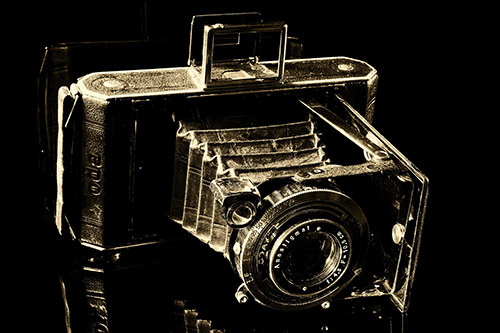 Although the first studies on Kirlian photography can be traced back to the late 1700s, this method was officially invented in 1939 by inventor and researcher Semyon Davidovich Kirlian together with his wife, teacher, and journalist Valentina Khrisanovna Kirlian. The Kirlian photographic process is based on a phenomenon called electrical coronal discharge, which results in visible ‘’auras’’ surrounding the objects photographed. This photography technique is also known as ‘’electrography’’, ‘’corona discharge’’, ‘’bioelectrography’’, ‘’gas discharge visualization’’ and ‘’electrography’’.
Although the first studies on Kirlian photography can be traced back to the late 1700s, this method was officially invented in 1939 by inventor and researcher Semyon Davidovich Kirlian together with his wife, teacher, and journalist Valentina Khrisanovna Kirlian. The Kirlian photographic process is based on a phenomenon called electrical coronal discharge, which results in visible ‘’auras’’ surrounding the objects photographed. This photography technique is also known as ‘’electrography’’, ‘’corona discharge’’, ‘’bioelectrography’’, ‘’gas discharge visualization’’ and ‘’electrography’’. 




























































































